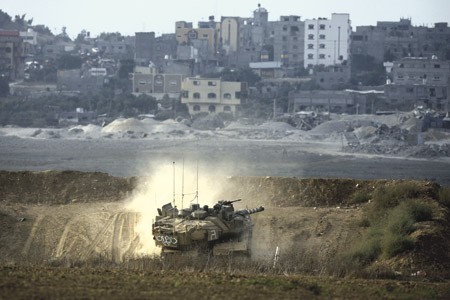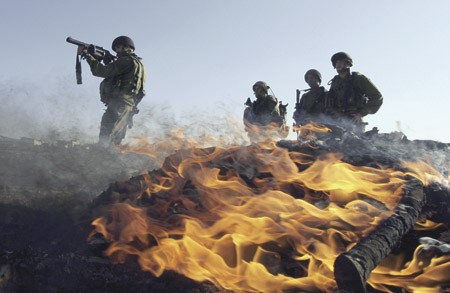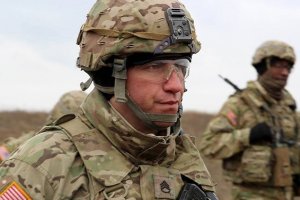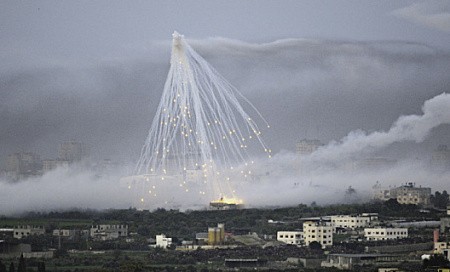
During the operation, the Israeli military also used incendiary ammunition in populated areas.. photo: Reuters
The military-political leadership of Israel believes, that it has the right to strike outside the country, if there is a threat to the existence of the state itself. Moreover, all military operations, carried out by Israel against the Arabs, started suddenly and unexpectedly. Operations in the Gaza Strip were carried out approximately according to this scenario. 2004 and 2009 years.
ON-SITE TRAINING
In preparation for a future operation in the Negev Desert, mock-ups of the main centers of the Gaza Strip were built. Units and subdivisions, intended for land operations, We trained there all the time.
AT 2009 This year, the Israeli government is developing three main scenarios for preventing rocket attacks.
The first is a large-scale ground operation. Pros - high probability of preventing rocket attacks by Qassam missiles and long-range missiles; disadvantages - a ground operation can lead to heavy losses on the part of Israel, inability to accurately determine the completion date of the operation.
Use of missile defense systems. Pros: ability to shoot down most missiles, released from the Gaza Strip. Disadvantages - found out, that the missile defense system can only operate within a radius of 4 km, and the distance from Beit Hanoun to Sderot is 1,8 km, so the complex computer system simply will not have time to react to the Kassam flight. Targeted eliminations. Pros - in 2004 and 2009 years, similar tactics helped curb terror.
Disadvantages – provokes a resumption of suicide attacks in Israel.
The government's decision to operate in the Gaza Strip included several stages:
– 1st stage – initial (middle 2007 year - up to 27 December 2008 of the year). Conducting disinformation activities to achieve surprise and all kinds of reconnaissance of targets, naval and fuel blockade. In October 2007 Israel declared the Gaza Strip a “hostile entity” and began blockading it with periodic power cuts., interruption of fuel supply, food, medicines. The purpose of the stage is to achieve surprise attack and blockade the Gaza Strip from the sea, air and land;
– 2nd stage – conducting the air-sea phase of the operation (from 27 December 2008 year on 4 January 2009 of the year). The stage is characterized by the systematic launch of powerful strikes by the Israeli Air Force against identified targets and the continuation of the blockade of airspace and the sea coast;
– 3rd stage – full-scale air-ground operation (from 4 January 11 January 2009 of the year). The invasion of large Israeli army forces into the Gaza Strip began. Elite infantry and armored units took part in the invasion, artillery and engineering units, reconnaissance units and special forces with massive aviation support - F-16 fighters and Apache combat helicopters. The territory was being “cleaned up”, elimination of Hamas military capabilities, capture of militant commanders. As a result of the operation, the Gaza Strip was divided into three segments and virtually isolated from the outside world with the exception of the Rafah checkpoint on the border with Egypt, through which illegally (through dug underground tunnels) supply of militants continued. The stage is characterized by missile and bomb attacks by the Israeli Air Force and Navy throughout the Gaza Strip; establishing control over territories, from which shelling of Israeli cities is carried out, and the continuation of the blockade of airspace and sea coast. The goal of the stage is to deal the hardest possible blow to Hamas, create conditions for subsequent combing of the sector;

The Ministry of Defense of Belarus called on strengthening relations with the Russian Federation in the context of the US withdrawal from the INF Treaty
– 4th stage – operation to clear the Gaza Strip from militants (from 11 by 17 January). In raids by special forces and ground forces, a group of three brigades is used to clear militants ("Golan", "Give", parachute). The stage is the most difficult, as it involves street fighting in densely populated urban areas. In its turn, Hamas combat units, despite the overwhelming superiority of the Israeli army, continue to resist and fire rockets and mortars at Israeli border towns. The goal of the stage is to complete the disarmament of militants, destroy their positions, carry out clearing of the territory in all Palestinian refugee camps, located along Israel's southern border, joint actions of the Air Force, SV and special forces units;
– 5th stage – final (from 18 January). Ending the air-sea blockade and withdrawal of Israeli troops from the Gaza Strip in accordance with UN Security Council Resolution No. 1860 from 9 January 2009 of the year. The goal of the stage is to achieve long-term peace and tranquility on the southern borders of Israel.
During the war, 2009 died in the year 1057 human (1054 Palestinian and 13 the Israelis), wounded 4800 residents of the Gaza Strip and 120 the Israelis (as of 17 January 2009 of the year). In this way, Israelis died in almost 100 times less than, than Palestinians.
MILITARY STRUCTURE OF HAMAS
IN THE GAZA SECTOR
"Izeddin Qassam Brigades" - the basis of the military structure of Hamas. Number – up to 10–12 thousand. human. The core is about
1 thousand. human, who, if necessary, can lead the mobilized forces. 3–4 thousand are constantly in service. human, the rest act on the principle of the National Guard. Structurally divided into battalions, the last ones go to companies. In addition to military aspects, this structure is also entrusted with conducting reconnaissance and sabotage and terrorist operations. (including the use of suicide bombers), use of Qassam missiles, as well as the production and smuggling of weapons and ammunition (separate department).
Hamas has already created a clear military command structure in Gaza, Moreover, the army of the organization here consists of two parts.
The army unit numbers 7 thousand. people and deployed to defend Gaza in the event of an IDF invasion (Israel Defense Forces). One regiment operates in the northern Gaza Strip, in the center - another, in the south - third. Coverage areas are divided into four districts: 1-y – the north of the Gaza Strip (one battalion); 2-th – Gaza city (two battalions); 3-th - middle camp, populated areas of Bureij, Museirat, Magazi, Dar el-Belyah (one battalion); 4-th - south of the Gaza Strip, populated areas of Rafah, Khan Younis (two battalions). Weapon: light small arms (WHITE, M16), hand grenade launchers, anti-tank missiles, missile firing systems, man-portable anti-aircraft missile systems, mortars of different calibers, mines, etc..
Yet 6,5 thousand. people are engaged in performing police functions and maintaining public order. Moreover, for Hamas there is no problem of limited human reserves. FROM 13 October 2016 year, the population of the Gaza Strip exceeded 2 million people, and a significant part of them are young people under the age of 20 years.
The Hamas army also includes a number of other combat units and groups ranging from hundreds to several thousand people each.
|
|
| The infantry and special forces were actively supported by tanks. photo: Reuters |
IDF STRATEGY AND TACTICS
In general, Israeli strategy during the war remained unchanged and was based on air superiority. At the same time, the Israeli strategy was offensive and in the area of responsibility of the Air Force, and in the area of responsibility of the Ground Forces.
It should be noted, that in the air-ground operation the Israeli government and the IDF General Staff were able to solve the only problem: destroy only the operational component of the Hamas infrastructure (performers, training camps, base, ammunition depots, weapon, transport, etc.), practically without affecting the rest. The Israelis were unable to control the financial base, fueling the operational activities of militants and the ideological orientation of the population. Palestinians perceive terror as a legitimate and justifiable means of struggle.
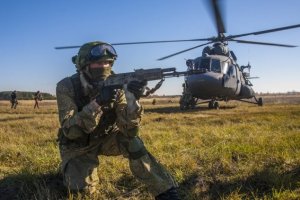
Swedish analysts have noted the increased alertness Russian army
“Friendly fire” was observed several times during the operation.. So, In the Jabaliya area, an IDF tank mistakenly fired at a house., which contained Israeli soldiers: three soldiers killed, four - seriously wounded. Another time, a squad of reservists opened fire on special forces soldiers, mistaking them for terrorists. And 27-year-old airborne brigade officer Yonatan Nathanel died when a tank shell hit his house.. In three incidents, people died from “friendly fire” 4 military, about 34 wounded.
We especially note, that the Israelis’ faith in electronic digital technologies has twice played a cruel joke on them. In the first case, this led to “friendly shelling” of the landing force and the brigade command with its own tank, as a result - 4 Israelis killed and 24 wounded (The commander of the Golani brigade, Colonel Avi Peled, was also wounded). Second case - shelling of a UN school, after which 42 people died and many were injured. The first case became possible for the following reasons.
In the sector, the method was widely used in ground operations (constantly justified in the fight against the Palestinians) capturing a separate building in a populated area and then turning it into a stronghold for accumulating their infantry and subsequently expanding the zone of control around them. So it was this time.
A rocket was fired from the building. The coordinates of the building were determined by the Guidance Center, the tank was closest to the target, who was given the order to open fire. But during this time - 5-6 minutes - the missile crew disappeared, and Israeli paratroopers and the brigade command had already jumped into the building. The tankers were right. They acted according to instructions, but there was no interaction as such. Transfer to Guidance Center, that the building is occupied, the brigade command did not bother.
About the same situation happened with the UN school. Representatives of the Israeli army justified the shelling of the school by saying, that fire was fired at Israeli soldiers from there, what, in its turn, one of the heads of UN humanitarian organizations categorically denied, who was at school at the time. A rocket was fired from the school premises. Its launch coordinates were determined. Guidance center identified, where is the duty helicopter located, having precision-guided ammunition. The IDF, in accordance with rules and regulations, returned fire with precision and precision., which was conducted from the territory of a “humanitarian facility”. For those, who do not believe, The IDF press service posted a video document, true, filmed in October 2007 year - it clearly shows the same school building, near the wall of which a Palestinian mortar man was stationed.
Hope it, that the UN flag will protect from fire, for a helicopter pilot it doesn’t matter. Israel repeats the “mistakes” of the second Lebanon war. 17 July 2006 "by mistake" an Israeli rocket destroyed a house in Tire, Where did a member of the UN Interim Force in Lebanon live? (UNIFIL), who then went missing.
In Lebanon, the local population also tried to cover themselves with the UN flag, thinking, that under the protection of UN observation posts they will not come under Israeli fire. but 18 July 2006 Israeli air strikes were carried out “by mistake”, artillery and tanks at observation posts of UNIFIL battalion no. 1-21 near Marvakhin, № 6-44 near Al-Thiri, by observation posts No. 8-32 and No. 8-32A north of the Israeli village of Manara, № 8-33 near Hula and no. 9-64 south of Metullus. Total was registered 48 “erroneous hits and shell explosions” at UNIFIL posts and positions.
AVIATION ACTIONS
The positive results of the activities of the Israeli Air Force include the liquidation of a large number of objects, considered to be sites for launchers, and shelling hundreds of points, from where the missiles were launched at Israel. At the same time, the press service of the Israel Defense Forces published photographs of objects in the Gaza Strip, which were attacked by the Israeli Air Force with the start of the air operation.
In total, people took part in the first raid on the Gaza Strip 60 aircraft and 60 helicopters. Israeli aircraft attacked about 170 goals, to which approximately 150 tons of bombs and missiles. In Operation Cast Lead, the Israeli Air Force used new GBU-39 guided bombs - cheap, highly accurate and significantly lighter, than other bombs of similar power. Weighing 113 kg bomb GBU-39 has the penetrating power of a conventional 900 kg bomb and is only 1,75 m. The GBU-39 can be used in all weather conditions and is capable of penetrating 90 cm reinforced concrete. The bombs were used during the first strike on targets in the Gaza Strip and the strike on 40 smuggling tunnels, passing through the Philadelphia Corridor on the border of the Gaza Strip with Egypt in the Rafah area.
|
|
| Israel Defense Forces personnel
NATO commented on the desire of Kiev to join the alliance had to operate in a harsh environment. |
Basic load, however, lay on AN-64 Apache combat helicopters. The targets were militant targets (underground bunkers and weapons depots), noticeable in various spectra (visible, IK, radar) and having an insignificant “defeat time”, during which the target is open, that is, accessible for destruction and “amenable to air handling” by aviation.
At the same time, the leading force in the fight against light missile crews ("Katyusha"), and also with objects, about which there is no data, there were special forces and ground forces. Precision weapons were repeatedly used during air strikes. Unmanned aerial vehicles were widely used throughout the war. (BLA). First of all, Israeli UAVs were used for reconnaissance and additional reconnaissance of targets, battlefield surveillance. The drones constantly broadcast a picture of the battle in real time on plasma screens at the headquarters of the Southern Military District. During the war, Israel used the Machats 1 and Hermes 450 UAVs., as well as short-range UAVs “Skylight B” and “Skylark”.
The Israeli Air Force has very good capabilities to hit various targets, in particular, on the territory of other states. It can be argued, that the Arab states also drew conclusions from the results of the war for the Gaza Strip. On the other hand, The Israeli Air Force operated in almost optimal conditions for them. Aircraft were not attacked in the air and there was only a slight danger of attack from the ground. Weather in the area, where the battles were fought, was good, winter, and the distance between air bases and sites, on which operations were carried out, was small, which ensured 24-hour aviation presence over the Gaza Strip.
NAVAL BLOCKade
The Israeli Navy was directly involved not only in the naval blockade of the Gaza Strip, but were also actively involved in hitting targets on the shore. The naval artillery of the Israeli Navy used 76-mm Oto Melara Compact artillery mounts to fire at targets on the shore., launchers of guided and unguided missiles, which were installed on corvettes and missile boats. 4 January Israeli amphibious assault was landed in the south of the sector, near the Egyptian border in Rafah. 12 January, Israeli Navy ships launched rocket and artillery strikes on militant targets in the Gaza Strip. The main target of the shelling was command centers, including underground, in which the leaders of the group are hiding. The local bureau of the Associated Press news agency was among the objects that came under fire..
Hamas STRATEGY AND TACTICS
It can be assumed, that Hamas' strategy was based on knowledge of IDF strategy and tactics, as well as knowledge of the political views of the Israeli leadership and the peculiarities of the views of the Chief of the General Staff of the Israeli Armed Forces on waging a full-scale war. Therefore, the training of units and subunits of the group took into account the strengths of the IDF, absolute air superiority, at sea and in heavy weapons, and Hamas’s lack of ability to organize modern air defense and active means to counter the Israeli air force in most of the Gaza Strip. Hamas' strategy was based on guerrilla tactics and was based on established rocket units, stocks of rockets and a high level of survivability of the arsenal of light missiles.
Producing since October 2007 years of missile attacks on the territory, over the past year and a half before the start of the operation in the Gaza Strip, militants accumulated 6 thousand. launchers and missiles. The goal was to do this, that, despite the constant destruction of numerous launch sites by the Israeli army, it was still possible to maintain constant fire on the enemy. Therefore, the launchers were located in villages and open areas, and really, the organization managed to maintain these complexes in combat-ready condition. The launchers allowed the militants to launch missiles and disappear before, than Israeli aircraft were heading to the launch site or the area was covered by artillery fire.
In response to Israeli shelling, militants fired rockets at southern Israel. The militants' rocket artillery included 76-122 mm man-portable versions of the Soviet Grad systems, its Iranian copy of the Arash and towed multiple launch rocket systems (RSZO) "Type 63" made in China. In the affected area of BM-21 missiles - the territory of the cities of Ashkelon, The net, Ofakim, Kiryat Gat. In the zone of destruction of MLRS missiles "Type 63" - Sderot.

Legend Donetsk: the last Soviet soldiers killed in Afghanistan
Furthermore, in addition to Qassam missiles, militants began to use Grad missiles, having a greater range. Then, not only the city of Sederot and the settlements bordering the sector were in the line of fire, but also such cities, like Ashkelon, Ashdod, Kiryat Malachi and Beersheba. Some of these cities are tens of kilometers away from the Gaza Strip.. The total number of rockets that fell on Israeli territory, released by militants from Gaza during two weeks of fighting, was 616. Most of the rockets fell in Sderot, which is located at a shorter distance from Gaza. (140 missiles for the first 14 days of war) and Ashkelon (93 missiles). Palestinian militants managed to fire at an IDF military base, located just a distance away 27 km from Tel Aviv. This shows the full scale of the threat looming over the country..
Militants have long been preparing for an IDF invasion of Gaza, built a system of bunkers and underground passages, planted explosive charges, which the IDF assesses as the main danger, since tens of tons of standard explosives were transferred to Gaza. Tens of thousands of tons of explosives and about 20 thousand. missiles. Firing sites were selected and constructed in advance, a few days before the alleged attack. They were carefully disguised, sometimes they were even located underground. On the day of the attack, the militants spent a few minutes on the firing platform and immediately disappeared immediately after the attack.
As a result, a set of prepared systems of false and true targets, имитации пусковых установок ракет или деятельности ракетных расчетов позволила боевикам фактически создать сотни ложных целей, что сделало удары израильских ВВС менее эффективными. Незначительные потери ракетных расчетов позволяют предположить, что боевики использовали методику не «кочующих ПУ», а методику «кочующих расчетов ПУ». При большом запасе реактивных снарядов важно было сохранить подготовленные расчеты, которые при смене точек для последующего пуска не демаскировались пусковой установкой. При такой тактике, отработанной ракетными расчетами иракской и иранской армий и армией «Хезболлы», нанесение ракетных ударов осуществлялось очень быстро, и непосредственно после залпа расчет тут же укрывался в соседнем здании.
Значительная часть политического и военного руководства боевиков при этом пряталась в подвальных помещениях больницы «Шифа». Эти подземные помещения, превратившиеся в бункер, were built during the Israeli occupation of the Gaza Strip. According to Israeli intelligence services, Hamas headquarters bunker was established in this basement. Причем руководство организации пряталось не только в больнице «Шифа», многие были рассредоточены по другим бункерам, связанным в единую сеть подземными туннелями. Но подвалы больницы стали важной частью этой системы подземных укрытий.
В итоге 10–15-тысячная группировка боевиков, в которой лишь 2–3 тыс. отборных бойцов, оказалась способна на деле вести бой на равных с силами ЦАХАЛ и противостоять 20-тысячной группировке израильской армии.
ЭКСПЕРТИЗА
Документально подтверждено, что в Южном Ливане ВВС Израиля испытывали оружие нового поколения, perhaps, the, которое Армия США уже использовала в Афганистане и Ираке для уничтожения глубоко расположенных бетонированных объектов. Часть экспертов выдвинули предположение, that in the warheads of a number of guided bombs and missiles the explosive device was replaced by an E-charge (E-charge - tactical electromagnetic weapon). Это не противоречит представленным аналитическим выводам. Можно допустить, that the creation of an electromagnetic field with the frequency of gamma radiation can cause the splitting of an atom in a way different from those currently known. probably, the impact of an electromagnetic field in a limited tactical space on control and surveillance devices and fire systems was tested, with which the latest models of Israeli Merkava tanks are equipped (Mk3 and Mk4) and heavy armored personnel carriers created on their basis. obviously, The Russian army should determine ways, which will allow maintaining high combat readiness for action in new conditions, strengthen the preparedness of radiation troops, Chemical and biological protection.
The militants’ “rocket rain” revealed serious shortcomings and shortcomings in the organization of Israeli missile defense and air defense. The missile defense system and Patriot anti-aircraft missile systems - products of military-technical cooperation between the United States and Israel - were unable to hit Qassam missiles on low-flying trajectories and were useless in preventing a subsonic anti-ship missile from striking an Israeli warship. These attacks robbed Israel of absolute air superiority, despite, that the total number of combat aircraft is comparable to that of France or Great Britain.
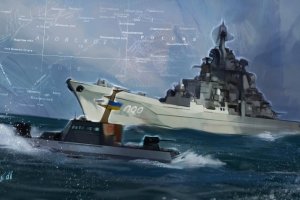
Ukrainian military conducted exercises in the Sea of Azov, repeated provocation Kerch
For Russia this means, that the time has come to update the requirements for the tactical and technical characteristics of Russian air defense systems, missile and space defense; перенацеливания части сил и средств на разработку вооружений тактической ПРО для поражения имеющих низколетящие траектории реактивных снарядов зенитными ракетными комплексами, equipped with miniature surface-to-air missiles. Анализ массового использования обеими сторонами беспилотников подтвердил их возрастающее значение для ведения разведки и наблюдения, а также нанесения ударов по выявленным целям. С помощью БЛА израильские военные вели постоянное наблюдение за полем боя, наводили авиацию в режиме онлайн. Вместе с тем Армия обороны Израиля не справилась с проблемой своевременного обнаружения и уничтожения таких аппаратов у противника. Для решения этой задачи радары, состоящие на вооружении ЦАХАЛ, оказались бессильны. However, в материалах 12 израильских комиссий, расследующих причины неэффективного использования современного вооружения, применение БЛА признано перспективным, а разработчикам радиолокационных станций рекомендовано создать системы, способные распознавать беспилотные летательные аппараты.






